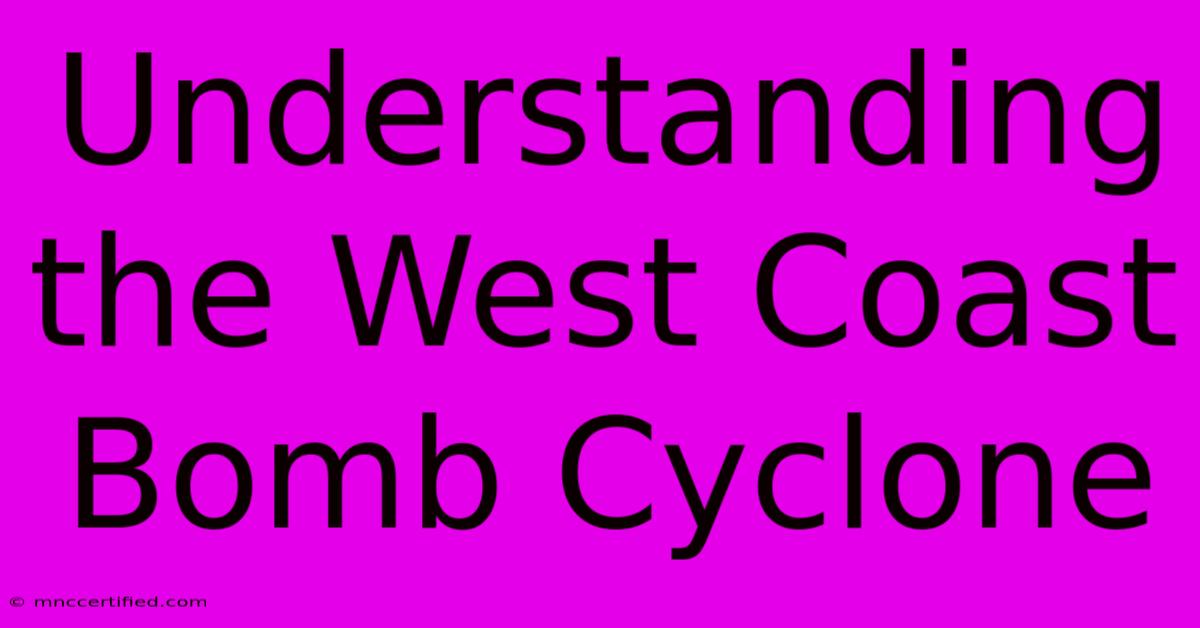Understanding The West Coast Bomb Cyclone

Table of Contents
Understanding the West Coast Bomb Cyclone: A Deep Dive into Atmospheric Fury
The West Coast, known for its stunning landscapes and mild climate, is not immune to the fury of nature. While hurricanes dominate the East Coast's headlines, the West Coast occasionally experiences a different kind of atmospheric bomb: the bomb cyclone. This article delves into the science behind these powerful storms, their impact, and how to prepare for them.
What is a Bomb Cyclone?
A bomb cyclone, technically known as a bombogenesis, is a mid-latitude cyclone that intensifies rapidly. This intensification is measured by a drop in central atmospheric pressure of at least 24 millibars in 24 hours. This rapid pressure drop fuels incredibly strong winds, heavy precipitation (often snow in mountainous regions and rain along the coast), and significant coastal flooding due to storm surge. It's the speed of the intensification that makes these storms so dangerous, giving less time for preparation and response.
Key Factors Driving Bomb Cyclones on the West Coast:
Several factors contribute to the formation and intensity of West Coast bomb cyclones:
- Temperature Gradient: A sharp contrast in temperature between a cold arctic air mass and a warm, moist Pacific air mass is crucial. This temperature difference provides the energy for the storm's development.
- Atmospheric Instability: Instability in the atmosphere allows for the rapid uplift of moist air, leading to the formation of intense low-pressure systems.
- Jet Stream Dynamics: The position and strength of the jet stream play a significant role. A strong, meandering jet stream can help to draw in warm, moist air and enhance the storm's intensification.
- Orographic Effects: Mountains along the West Coast, like the Cascades and Sierra Nevada, can further intensify precipitation as air masses are forced to rise and cool, leading to heavy snowfall.
Impacts of West Coast Bomb Cyclones:
The impacts of these powerful storms can be devastating and far-reaching:
- High Winds: Damaging winds can down trees, power lines, and cause significant structural damage to buildings.
- Heavy Precipitation: Intense rainfall leads to flooding in low-lying areas, mudslides, and landslides, particularly in areas with already saturated soil. Heavy snowfall in mountainous regions causes treacherous driving conditions and avalanches.
- Coastal Flooding: Storm surge, combined with high tides, can inundate coastal communities and cause significant damage to infrastructure.
- Power Outages: Downed power lines and damaged infrastructure can lead to widespread and prolonged power outages.
- Transportation Disruptions: Heavy snow, flooding, and high winds can severely disrupt air, road, and rail travel.
Preparing for a West Coast Bomb Cyclone:
Preparation is key to mitigating the risks associated with bomb cyclones. Here's what you should do:
- Stay Informed: Monitor weather forecasts closely and heed warnings from local authorities.
- Develop an Emergency Plan: Have a plan in place for evacuating if necessary, and ensure you have sufficient supplies of food, water, and medications.
- Secure Your Property: Bring loose objects indoors, trim trees near your home, and protect windows and doors from strong winds.
- Prepare Your Vehicle: Ensure your vehicle is winterized (if applicable) and you have a well-stocked emergency kit.
- Know Your Evacuation Route: Familiarize yourself with evacuation routes and designated shelters in your area.
The Difference Between a Bomb Cyclone and Other Storms:
It's crucial to distinguish a bomb cyclone from other weather events. While all bomb cyclones are intense storms, not all intense storms are bomb cyclones. The key difference lies in the speed of intensification – the rapid pressure drop within 24 hours is the defining characteristic of bombogenesis. This rapid intensification differentiates it from a typical nor'easter or winter storm, emphasizing its unique threat level.
Conclusion: Respecting the Power of Nature
West Coast bomb cyclones are powerful and unpredictable weather events that can have significant impacts. By understanding the science behind these storms, and by preparing adequately, we can minimize the risks and protect ourselves and our communities. Staying informed and following safety guidelines are crucial steps in ensuring safety during these intense weather phenomena. Remember, respecting the power of nature is paramount to survival.

Thank you for visiting our website wich cover about Understanding The West Coast Bomb Cyclone. We hope the information provided has been useful to you. Feel free to contact us if you have any questions or need further assistance. See you next time and dont miss to bookmark.
Featured Posts
-
Ex Military Base New Movie Studio
Nov 23, 2024
-
8 Letter Words Starting With Ro
Nov 23, 2024
-
Buy Coldplay Uk Tour Tickets Now
Nov 23, 2024
-
Dental Bonding Gap Before After
Nov 23, 2024
-
Plymouth Decision Impacts Rooneys Net Worth
Nov 23, 2024